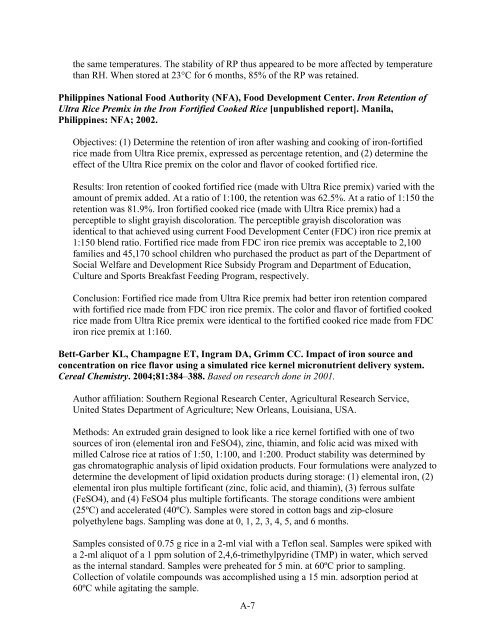The Research Behind the Ultra Rice® Technology - Path
The Research Behind the Ultra Rice® Technology - Path
The Research Behind the Ultra Rice® Technology - Path
You also want an ePaper? Increase the reach of your titles
YUMPU automatically turns print PDFs into web optimized ePapers that Google loves.
<strong>the</strong> same temperatures. <strong>The</strong> stability of RP thus appeared to be more affected by temperature<br />
than RH. When stored at 23°C for 6 months, 85% of <strong>the</strong> RP was retained.<br />
Philippines National Food Authority (NFA), Food Development Center. Iron Retention of<br />
<strong>Ultra</strong> Rice Premix in <strong>the</strong> Iron Fortified Cooked Rice [unpublished report]. Manila,<br />
Philippines: NFA; 2002.<br />
Objectives: (1) Determine <strong>the</strong> retention of iron after washing and cooking of iron-fortified<br />
rice made from <strong>Ultra</strong> Rice premix, expressed as percentage retention, and (2) determine <strong>the</strong><br />
effect of <strong>the</strong> <strong>Ultra</strong> Rice premix on <strong>the</strong> color and flavor of cooked fortified rice.<br />
Results: Iron retention of cooked fortified rice (made with <strong>Ultra</strong> Rice premix) varied with <strong>the</strong><br />
amount of premix added. At a ratio of 1:100, <strong>the</strong> retention was 62.5%. At a ratio of 1:150 <strong>the</strong><br />
retention was 81.9%. Iron fortified cooked rice (made with <strong>Ultra</strong> Rice premix) had a<br />
perceptible to slight grayish discoloration. <strong>The</strong> perceptible grayish discoloration was<br />
identical to that achieved using current Food Development Center (FDC) iron rice premix at<br />
1:150 blend ratio. Fortified rice made from FDC iron rice premix was acceptable to 2,100<br />
families and 45,170 school children who purchased <strong>the</strong> product as part of <strong>the</strong> Department of<br />
Social Welfare and Development Rice Subsidy Program and Department of Education,<br />
Culture and Sports Breakfast Feeding Program, respectively.<br />
Conclusion: Fortified rice made from <strong>Ultra</strong> Rice premix had better iron retention compared<br />
with fortified rice made from FDC iron rice premix. <strong>The</strong> color and flavor of fortified cooked<br />
rice made from <strong>Ultra</strong> Rice premix were identical to <strong>the</strong> fortified cooked rice made from FDC<br />
iron rice premix at 1:160.<br />
Bett-Garber KL, Champagne ET, Ingram DA, Grimm CC. Impact of iron source and<br />
concentration on rice flavor using a simulated rice kernel micronutrient delivery system.<br />
Cereal Chemistry. 2004;81:384–388. Based on research done in 2001.<br />
Author affiliation: Sou<strong>the</strong>rn Regional <strong>Research</strong> Center, Agricultural <strong>Research</strong> Service,<br />
United States Department of Agriculture; New Orleans, Louisiana, USA.<br />
Methods: An extruded grain designed to look like a rice kernel fortified with one of two<br />
sources of iron (elemental iron and FeSO4), zinc, thiamin, and folic acid was mixed with<br />
milled Calrose rice at ratios of 1:50, 1:100, and 1:200. Product stability was determined by<br />
gas chromatographic analysis of lipid oxidation products. Four formulations were analyzed to<br />
determine <strong>the</strong> development of lipid oxidation products during storage: (1) elemental iron, (2)<br />
elemental iron plus multiple fortificant (zinc, folic acid, and thiamin), (3) ferrous sulfate<br />
(FeSO4), and (4) FeSO4 plus multiple fortificants. <strong>The</strong> storage conditions were ambient<br />
(25ºC) and accelerated (40ºC). Samples were stored in cotton bags and zip-closure<br />
polyethylene bags. Sampling was done at 0, 1, 2, 3, 4, 5, and 6 months.<br />
Samples consisted of 0.75 g rice in a 2-ml vial with a Teflon seal. Samples were spiked with<br />
a 2-ml aliquot of a 1 ppm solution of 2,4,6-trimethylpyridine (TMP) in water, which served<br />
as <strong>the</strong> internal standard. Samples were preheated for 5 min. at 60ºC prior to sampling.<br />
Collection of volatile compounds was accomplished using a 15 min. adsorption period at<br />
60ºC while agitating <strong>the</strong> sample.<br />
A-7
















